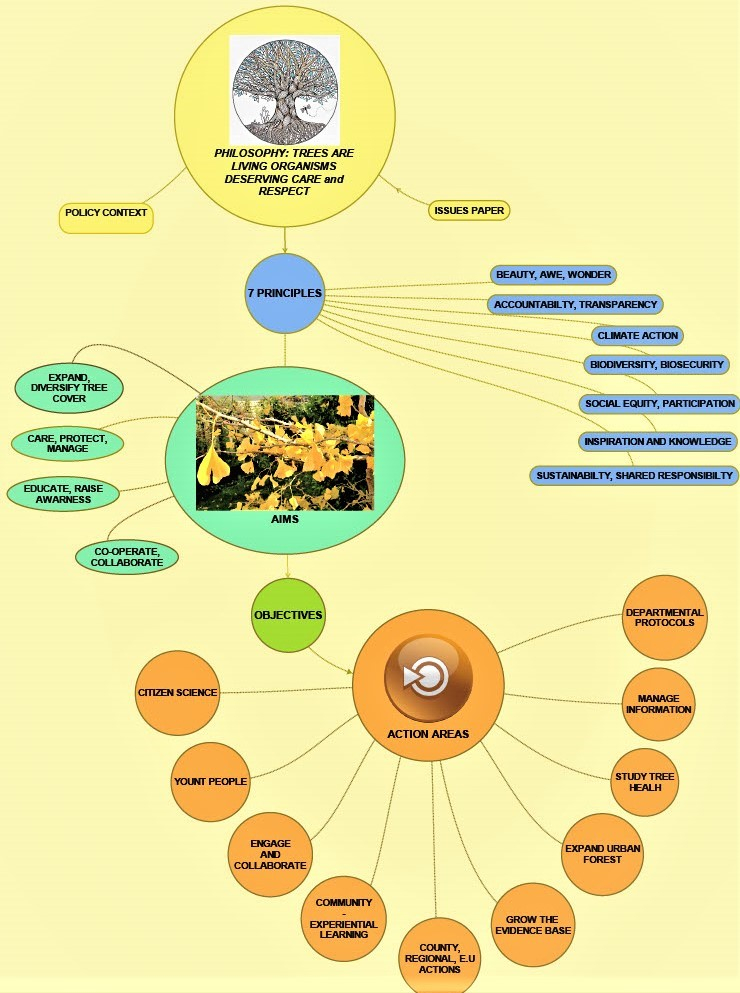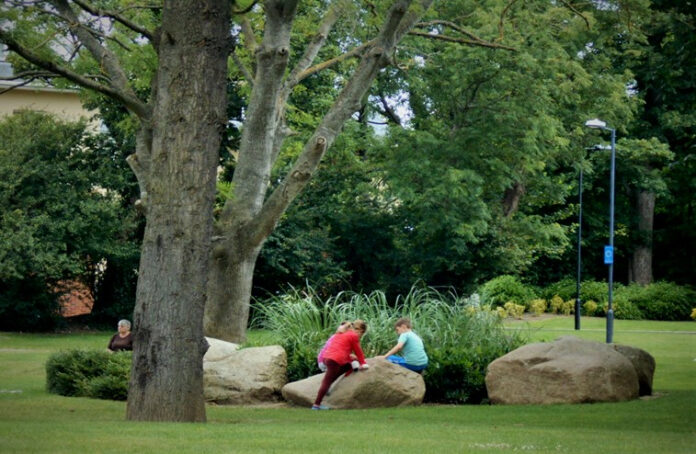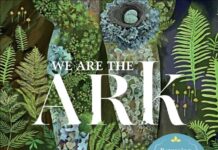Aidan Ffrench gives a valuable insight into the planning behind the DLR Trees and Urban Forestry Strategy 2022-2031 – A natural approach to human health and well-being.
TREES AND PEOPLE – A MUTUALLY BENEFICIAL RELATIONSHIP
Trees are intrinsic to human life. That may not always be so obvious, and we tend to take trees for granted. However, consider this statement from John Parker, Chief Executive of the Arboricultural Association, “a tree basically makes itself out of air, water, soil, and sunshine” That’s quite something! Trees are truly amazing. And trees bring many benefits to humans, including clean air, oxygen, shelter, food, biodiversity, carbon sequestration, and spiritual sustenance. Increasingly, people recognise the vital role of trees in human health, well-being, and climate. The pandemic highlighted the need for us to reconnect with and care for nature, especially in urban areas, where 63% of Irish people live. And, just as humans need each other and live in communities, so do trees. Scientists such as Professor Suzanne Simard (suzannesimard.com) are finding that trees function as communities of solidarity, supporting each other through symbiotic relationships with mycorrhizal fungi. Our connections with each other and trees are no less important. Embracing this holistic understanding, in late 2020, Dún Laoghaire-Rathdown County Council embarked on a review and update of its first Tree Strategy (2011-2015). It is anticipated that the new strategy will be launched in March 2022.
DEVELOPING THE NEW STRATEGY
Preparation of the new strategy is mandated by Action 14 of the dlr Climate Action Plan 2019-2024. The review audited the outgoing strategy’s Action Plan, finding that most of its 14 actions had not been completed owing to insufficient staff resources, principally the lack of a Tree Officer. A Literature Review of best international exemplars was conducted, focusing on cities including Greater Lyon (France), Pittsburgh, and Melbourne. Key lessons included building capacity, to delivery goals, maintaining an up-to-date database, engaging civil society through collaboration, and investing in appropriate human, technical, and educational resources. In contrast to the first strategy, a draft was only written once a two-part exercise was undertaken – an Issues Paper followed by an in-depth Stakeholder Engagement process. The Paper identified several key challenges and opportunities for Public Consultation, including the coincidence of tree inequity and social disadvantage, increasing tree losses due to developments, lack of a Tree Officer, citizen tree stewards, and citizen science. Sixty-four submissions were received, mostly from individuals, with nine from county councillors, and one from a national organisation (Bat Conservation Ireland). Participants were generally well-disposed towards trees and expressed interest in being involved in tree activities. For example, 78% were interested in a Citizen Science project and/or a voluntary Tree Stewardship Scheme. There was strong support for drafting a new strategy along with calls for an investment of human resources to manage the Urban Forest. The main topics of concern were the lack of a Tree Officer, tree losses in built developments, biodiversity in tree planting, an educational campaign, and more tree planting. The Consultation was followed by participatory Stakeholder Engagement which had the benefit of early identification and assessment of the views of a wide range of stakeholders, before writing the strategy. A key goal was to ‘activate’ delivery of the strategy’s goals by identifying potential partners. Participation was interactive with proforma questionnaires and workshops with five Focus Groups: –
- Businesses, Institutions, Schools, Colleges, Private Landowners
- Community Groups (Public Participation Network, residents’ associations, Tidy Towns, gardening groups)
- Internal – dlr Staff – across grades, departments
- Youth 1 (dlr Youth Parliament – Comhairle na nÓg)
- Youth 2: Young People living in Disadvantaged Areas
Key takeaways of the Focus Group workshops:-
- the need to change perceptions and raise awareness of the value of Trees as Living Organisms
- The Strategy should identify collaborative actions between the Council and civil society in Communication, Education, Community Participation and Tree Care
The Strategy comprises 4 main parts: –
- Why A Strategy – Vision, Philosophy, Principles, and Objectives
- What We Have – The County’s Tree Resources
- What We Stand For – Policy Statements and Practices
- What We Will Do – Implementation (Action Plan)

TOWARDS A SHARED VISION – A COUNTY CULTURE OF TREE CARE
The strategy emphasises that everyone is responsible for trees. While the county is well-provided with trees (19% canopy cover), the Council is directly responsible for only 33% of the tree cover, with the remaining 66% in private and institutional ownership. Care for the county’s trees extends beyond the Council to include individuals, communities, educational bodies, NGOs, private landowners, developers, businesses, and State bodies. Managing and expanding tree cover requires a collaborative approach driven by a Shared Vision of collective responsibility. The strategy’s vision is that, by 2031 the citizens of Dún Laoghaire Rathdown will have fully embraced a Culture of Care for Trees and will share the environment with trees in an inspiring, healthy Urban Forest, receiving benefits that maximise human wellbeing and climate resilience. The vision will be achieved by sharing well-designed places with trees – what I call informed co-habitation.
Ethical Philosophy – Trees are Living Dynamic Organisms
Beyond human-focused, utilitarian values, trees have their own inherent value as living organisms. The sacredness and dignity of trees was recognised by our ancestors in pre-Christian Ireland and Celtic Christianity. Likewise, the strategy is founded on an ethical philosophy of consistent respect for trees, recognising trees as living organisms, not mere objects. Dlr will apply this philosophy by, for example, ensuring that tree planting is designed to meet the functional needs of trees above and below ground, providing sufficient space, water, and maintenance to optimise growth.
Key Policies updates
- Right Tree, Right Place, Right Reasons, Rightly-Planted
- Resolving Inequity in Tree Cover
- Diverse Planting: the 10-20-30 Rule
- Mini-Forests and Tiny (Pocket) Forests
- Biosecurity and Procurement
Conclusion – From rhetoric to reality
The strategy is ambitious in its scope and intent. Consistent commitment to the implementation of its Action Plan will be vital to success. The Council will appoint a Tree Officer to coordinate the delivery of the Plan. Priority actions in 2022 – 2025:-
- Re-commence Tree Surveys
- Digitise Annual Tree Planting Programme
- Develop a Tree Stewardship Programme
- Develop Urban Woodlands and ‘Mini-Forests’
- Prepare Street Tree Planting Plans
- Develop new rules for developers
  Aidan Ffrench has been an Executive Landscape Officer with Dún Laoghaire-Rathdown County Council’s Parks and Landscape Services since 1994. His work portfolio includes landscape design projects, parks master planning, and urban planning. Currently, he is project manager for the dlr Trees and Urban Forestry Strategy. |








